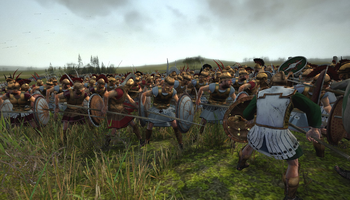Second Sabrian War: Difference between revisions
(Created page with "{{Infobox military conflict | conflict = Second Sabrian War | width = | partof = | image = 350px | image_size = | alt...") |
mNo edit summary |
||
| Line 2: | Line 2: | ||
| conflict = Second Sabrian War | | conflict = Second Sabrian War | ||
| width = | | width = | ||
| partof = | | partof = the [[Sabrian Wars]] | ||
| image = [[File:SecondSabrianWar.png|350px]] | | image = [[File:SecondSabrianWar.png|350px]] | ||
| image_size = | | image_size = | ||
Revision as of 16:20, 16 September 2021
| Second Sabrian War | |||||||||
|---|---|---|---|---|---|---|---|---|---|
| Part of the Sabrian Wars | |||||||||
 Sabrian and Makedonian soldiers during the Battle of Asakumo | |||||||||
| |||||||||
| Belligerents | |||||||||
|
|
| ||||||||
| Commanders and leaders | |||||||||
|
|
| ||||||||
| Strength | |||||||||
|
"Millions" (contemporary sources) 600,000-800,000 (modern sources) | Hundreds of thousands | ||||||||
| Casualties and losses | |||||||||
| Heavy | Heavy | ||||||||
The Second Sabrian War was the second and final conflict of the Sabrian Wars. It was fought between the Makedonian Empire and the Sabrian Empire from 680 to 692 CE. The war was a continuation of the First Sabrian War that arose over disputes over the spheres of influence of the respective powers. Larger in scale and longer in duration than the first conflict, the Second Sabrian War involved foreign fighters and mercenaries from across Tyran and was one of the largest wars of late antiquity, with an estimated 1.5 million soldiers and sailors fielded by the two sides at the apex of the fighting.
Deinokrates III, who had led the Makedonians to victory in the first war, died in 676 CE, leaving his son Prexinos I to ascend the throne. Prexinos, who had been too young to fight in the previous conflict, saw the continued Sabrian presence on the Siduri continent as an unnacceptable strategic threat, but was reluctant to go to war unprovoked out of fear of aggravating Makedonian allies and vassal states in eastern Siduri who were not eager for another destructive conflict. In an effort to undermine the Sabrians Prexinos began funneling weapons and supplies to Knichan tribes who were engaged in a low intensity conflict with the Sabrian protectorates along the Knichan coast. Legate Artoria Flavina eventually raised an army to subjugate the Knichan tribes, which Prexinos labeled an aggressive move on the part of Sabria that threatened Makedonian security interests and invaded Knichus.
The Sabrians were able to repel the Makedonians initially, but a second Makedonian campaign drove the Sabrians back to the coast. The Sabrians attempted an invasion of southern Quenmin in 682 under Maximus Caldus, which raged on for two years before it was defeated by Eniopus of Pylla. In 684 the Makedonians began constructing a fleet in eastern Quenmin to challenge the Sabrians at sea and blockade Sabrian ports along the Knichan coast, which led to a prolonged naval campaign that ended indecisively. The Sabrians landed another army in Knichus in 686 under Lucia Mariniana, which defeated the armies of Hegesinos the Younger before the Sabrians suffered another defeat at the Battle of Mersako. By 687 the last of the Sabrian cities along the Knichan coast has been captured or destroyed, which led Legate Flavina to sue for peace. The continued presence of Sabrian forces on Lirinya concerned Prexinos, who refused negotiations and ordered an invasion of the island. After a sustained naval buildup the Makedoniand landed in eastern Lirinya in 689, and managed to conquer roughly a third of the island between 689-691. In 692 the Sabrian army under Tiberius Decmus met and defeated the Makedonians under Kallistratos at the Battle of Asakumo, then proceeded to recapture the rest of Lirinya. Faced with the failure of the invasion, Prexinos agreed to a peace treaty.
The terms of the treaty forbid the Sabrians from establishing holdings on the continent of Siduri, while in exchange the Makedonians recognized Lirinya as Sabrian soil and were limited to a fleet of 50 warships in the Bara Sea. Although the Makedonians had driven the Sabrians from Siduri, the failure of the Lirinya campaign and the decisive defeat of the Makedonian armies left many contemporary historians to label the war a Sabrian victory. Nevertheless, the war effectively marked the end of the Sabrian Empire as a major power in eastern Siduri. Sabria would enter into a steep decline and eventually dissolve itself less than two centuries later. As a result of their conquest the Makedonians would acheive their greatest territorial extent, though within a few hundred years they would lose control of all of eastern Siduri.